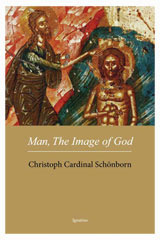Icons and the Mystery of Christ

Icons and the Mystery of Christ | The Introduction to Man, the Image of God: The Creation of Man as Good News | Christoph Cardinal Schönborn | Ignatius Insight
I start this meditation by looking at the feast of the Ascension. The angels say to those "men of Galilee" who cannot bring themselves to look  away from the cloud that has hidden Jesus, carrying him away, "This Jesus, who was taken up from you into heaven, will come in the same way as you saw him go into heaven" (Acts 1:11).
away from the cloud that has hidden Jesus, carrying him away, "This Jesus, who was taken up from you into heaven, will come in the same way as you saw him go into heaven" (Acts 1:11).
More than thirty years ago, in the first edition of my book God's Human Face: The Christ Icon, I remarked concerning what the angels said,
The prediction that he would return "in the same way" as they had seen him ascend implies the task for the disciples left behind, really the Church, to keep alive the remembrance of his face.... The icon is an expression of his living remembrance: it commemorates not merely a man from the distant past, but him who as man was glorified through suffering and the Cross, who is alive now and "intercedes for us with the Father", and whose return to us has been promised. The icon is a connecting link between the Incarnation and the return, between the first and the last coming of the Lord. The icon not only perpetuates the memory of the Incarnation, it is also a constant reminder of the promised return of Christ. This is why the Eastern Church considers the icon of Christ an indispensable element of the profession of the Christian Faith. The Eastern Church sees the icon as a condensed version of the Creed. [1]
The icon of Christ: for many Christians, the Eastern tradition of icons, their painting and their spirituality, has become something like a rallying point, a place where all Christians can meet. Icons are present more or less everywhere in the Church, both Eastern and Western. Their language, their symbolism, and their influence seem truly to touch the hearts of many of our contemporaries. People have often wondered why, in our own day, the art of the icon has now come to be seen as a special way of expressing the Christian faith.
There may be a "fashionable" side to this (the accusation some of the Orthodox make against Western Christians, under the impression that their Eastern tradition is wrongly "used" by Westerners). I think there is something deeper here. The sensus fidei recognizes in the Eastern tradition of icons a kind of "canonical" expression of our faith, an expression going beyond fashion and the cultural variations of Christian artistic language. Icons are not timeless; they do have stylistic variations, schools, "cultural colorations"· they are not static or immobile, the reproach often leveled against them. What is the secret of their attraction, then, the key to understanding their mystery? What is the reason for the great consistency in their expression?
Carl E. Olson's Blog
- Carl E. Olson's profile
- 20 followers



